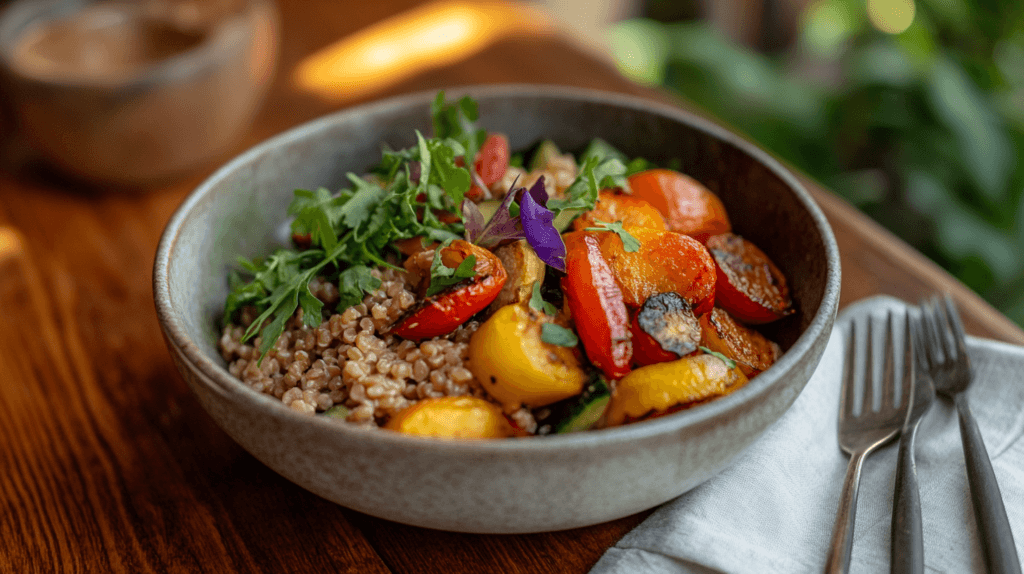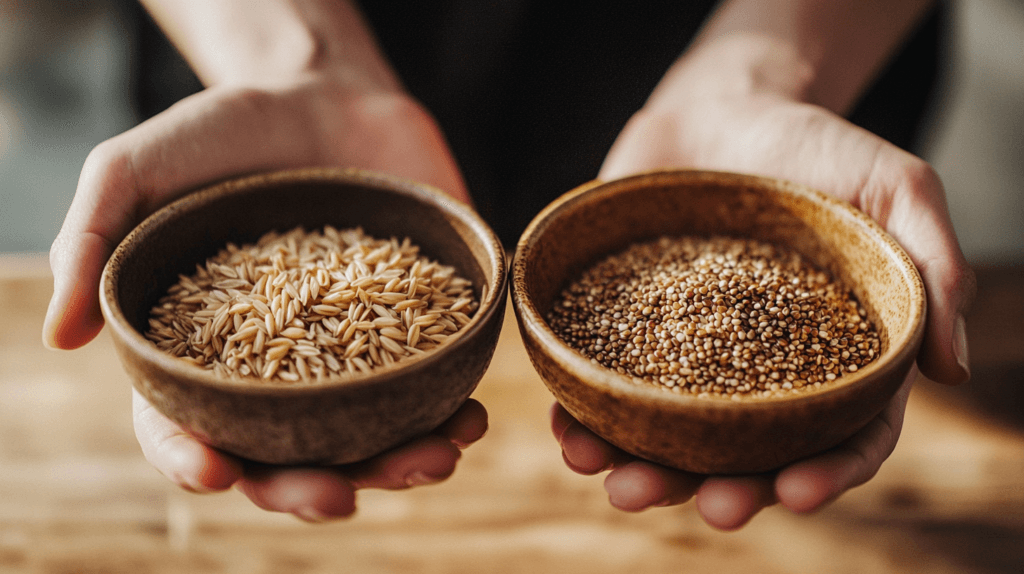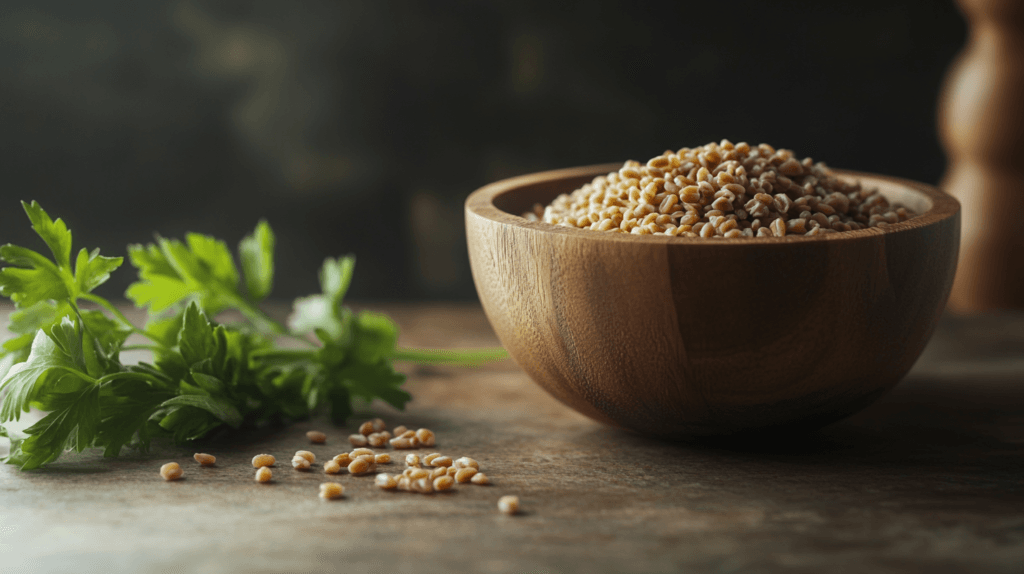If you’re someone who loves experimenting with ancient grains or following a specific dietary regimen, you’ve likely come across farro. Known for its nutty flavor and chewy texture, farro has become a popular choice for salads, soups, and grain bowls. But one question remains crucial for people with gluten sensitivity or celiac disease: Is farro gluten-free? The short answer is no, farro is not gluten-free. However, there’s much more to understand about this grain, including its origins, nutritional value, and suitable alternatives for those avoiding gluten.
This article dives deep into farro’s gluten content, explores its health benefits, and provides gluten-free alternatives so you can make informed dietary choices. Let’s start by understanding what farro is and how it fits into the world of grains.
Table of Contents
What is Farro?
Definition and Origin of Farro
Farro is an ancient grain that dates back thousands of years and was a staple in the diets of early Mediterranean and Middle Eastern civilizations. Often referred to as the “mother of all wheat,” farro encompasses three types of hulled wheat species: einkorn, emmer, and spelt. Its popularity has surged in recent years due to its versatility in recipes and its rich nutritional profile.
Different Types of Farro
Farro can be classified into three main varieties:
- Einkorn: The oldest and least modified species of wheat, einkorn has a lighter and softer texture.
- Emmer: Also known as “true farro,” this variety is the most common and widely available in stores.
- Spelt: Spelt is often confused with farro but is technically its own species of wheat. It’s more commonly used in baking due to its relatively mild flavor.
Each type contains gluten, but the gluten structure can vary slightly, which may affect how it’s digested.
Farro vs. Other Ancient Grains
Farro often draws comparisons to other ancient grains like quinoa, amaranth, and teff. While these grains share a similar earthy flavor and nutritional density, farro is distinct due to its wheat-based origin, which inherently makes it a gluten-containing grain. By contrast, quinoa and amaranth are naturally gluten-free, making them suitable alternatives for people with gluten intolerance.
Understanding Gluten
What is Gluten?
Gluten is a group of proteins found in certain grains, including wheat, barley, and rye. It acts as a binding agent, giving baked goods their elasticity and chewy texture. While gluten is harmless for most people, it can trigger adverse reactions in those with celiac disease or gluten sensitivity.
Gluten Sources in Grains
Common grains containing gluten include:
- Wheat (including farro, spelt, and durum)
- Barley
- Rye
- Triticale (a hybrid of wheat and rye)
These grains should be avoided by individuals following a gluten-free diet. Farro, being a type of wheat, falls into this category.
Gluten-Free vs. Low-Gluten Grains
It’s important to note the distinction between gluten-free and low-gluten grains. While farro contains less gluten compared to modern wheat varieties, it is not safe for those with celiac disease or severe gluten intolerance. Grains like quinoa, rice, and buckwheat are entirely free of gluten and are better options for gluten-sensitive individuals.
Is Farro Gluten-Free: The Truth
Does Farro Contain Gluten?
Yes, farro does contain gluten. As a member of the wheat family, farro inherently includes gluten proteins, which makes it unsuitable for people with gluten-related disorders. While some individuals with minor gluten sensitivities may tolerate ancient grains like farro better than modern wheat, it is not a gluten-free food.
How Farro is Processed and its Gluten Content
Farro is typically sold in three forms:
- Whole Farro: Retains its outer husk, requiring soaking before cooking.
- Semi-Pearled Farro: Some of the bran is removed, reducing cooking time but retaining some fiber.
- Pearled Farro: Fully polished, making it quicker to cook but less nutrient-dense.
Processing does not remove gluten from farro, so even pearled farro contains gluten.
Why Farro is Not Considered Safe for Celiac Disease
For those with celiac disease, consuming even trace amounts of gluten can damage the small intestine and lead to severe health issues. Since farro is wheat-based, it poses a high risk for cross-contamination and cannot be included in a gluten-free diet. Even if marketed as “ancient” or “healthier” wheat, farro is unsafe for individuals with gluten-related conditions.
Health Benefits of Farro
While farro is not gluten-free, it offers a range of health benefits for individuals who can tolerate gluten. Packed with nutrients, farro is often considered a superfood in the grain world.
Nutritional Profile of Farro
Farro is an excellent source of:
- Fiber: A single serving of farro provides a substantial amount of dietary fiber, aiding digestion and promoting gut health.
- Protein: With about 5-7 grams of protein per serving, farro supports muscle repair and overall growth.
- Vitamins and Minerals: Farro contains magnesium, zinc, and B vitamins, all of which are crucial for energy production, immune function, and overall well-being.
- Antioxidants: This ancient grain boasts antioxidants that help combat inflammation and reduce the risk of chronic diseases.
Benefits of Eating Farro (For Non-Gluten-Sensitive Individuals)
- Improved Digestive Health: The high fiber content in farro promotes regular bowel movements and supports a healthy gut microbiome.
- Sustained Energy: Its complex carbohydrates release energy slowly, making farro an ideal choice for athletes and busy individuals.
- Heart Health: Farro’s magnesium and fiber help reduce cholesterol levels and regulate blood pressure.
- Weight Management: Farro is low in calories and high in nutrients, which can keep you feeling full and reduce unnecessary snacking.
Comparison of Farro with Gluten-Free Grains
Farro is often compared to gluten-free grains like quinoa, millet, and buckwheat. While these gluten-free options are also nutritious, farro stands out for its unique combination of fiber, protein, and complex carbs. However, individuals with gluten sensitivity must avoid farro and choose alternatives that provide similar benefits without the risk of triggering adverse reactions.
Gluten-Free Alternatives to Farro

For those avoiding gluten, there are several excellent substitutes for farro that offer similar textures, flavors, and nutritional benefits.
Quinoa: A Nutrient-Dense Substitute
Quinoa is a fantastic gluten-free alternative to farro. Known for its nutty flavor and fluffy texture, quinoa is a complete protein, meaning it contains all nine essential amino acids. It’s versatile in cooking and can be used in salads, soups, or as a base for grain bowls.
Buckwheat: A Protein-Rich Option
Despite its name, buckwheat is entirely gluten-free and unrelated to wheat. It has a robust, earthy flavor and works well in porridges, pilafs, or as flour for gluten-free baking. Buckwheat is rich in antioxidants and offers a solid dose of protein and fiber.
Millet: A Mild-Tasting Ancient Grain
Millet is a small, round grain that’s naturally gluten-free. It has a mild, slightly sweet flavor and can be used in place of farro in recipes like salads or side dishes. Millet is easy to digest and rich in magnesium, making it a great choice for people with gluten sensitivities.
Other Gluten-Free Grains (Teff, Sorghum, Amaranth)
- Teff: A tiny grain from Ethiopia, teff is packed with iron and calcium, making it a nutrient-dense option.
- Sorghum: This grain has a chewy texture and mild flavor, perfect for soups or stews.
- Amaranth: Known for its peppery taste, amaranth is a protein-rich, gluten-free grain that can be cooked like porridge or used in baked goods.
Cooking and Using Farro
For those who can tolerate gluten, farro can add a flavorful and nutritious touch to various dishes.
How to Cook Farro
Cooking farro is straightforward:
- Rinse the farro thoroughly under cold water.
- Combine farro with water in a 1:2.5 ratio in a pot.
- Bring to a boil, then reduce heat and simmer until the grains are tender (20-40 minutes, depending on the type of farro).
- Drain excess water and serve.
Popular Farro Recipes
Some favorite ways to use farro include:
- Farro Salad with Roasted Vegetables: A hearty and wholesome dish perfect for meal prep.
- Farro Risotto: A healthier twist on traditional risotto, offering a nutty flavor and chewy texture.
- Farro Soup: Adds a hearty element to soups and stews, making them more filling.
Tips for Substituting Farro with Gluten-Free Options
If you’re recreating a recipe that calls for farro but need a gluten-free substitute, consider these tips:
- Use quinoa for a lighter texture.
- Opt for sorghum or buckwheat for a chewy, hearty bite.
- Cook gluten-free grains with broth or herbs to mimic farro’s nutty flavor.
FAQs About Farro and Gluten

Can Farro Be Made Gluten-Free?
No, farro cannot be made gluten-free because it is inherently a wheat-based grain and contains gluten. For a gluten-free alternative, explore Are Corn Tortillas Gluten-Free?, which discusses naturally gluten-free grains.
Is Farro Safe for Gluten Sensitivity Without Celiac Disease?
Some people with mild gluten sensitivity may tolerate farro better than modern wheat. However, it’s important to consult a doctor or dietitian before adding it to your diet. If you’re looking for gluten-free dinner ideas, check out Gluten-Free Dinner Recipes.
Can Gluten-Free Labeled Products Contain Farro?
No, gluten-free labeled products cannot contain farro. Foods with this label must meet strict standards, ensuring they contain less than 20 parts per million (ppm) of gluten. You might enjoy this guide on Does Crumbl Cookie Have Gluten-Free Options? for more insights into certified gluten-free treats.
What’s the Difference Between Spelt and Farro?
Spelt is a specific type of wheat, while farro is a general term encompassing einkorn, emmer, and spelt. Both contain gluten, but their textures and cooking times may vary.
Is Farro Better Than Wheat for Health?
Farro is less processed than modern wheat and has a higher nutrient content. However, it still contains gluten and is unsuitable for those with gluten sensitivity or celiac disease.
How to Test for Gluten Sensitivity at Home?
At-home tests for gluten sensitivity are available, but it’s always better to consult a healthcare professional for an accurate diagnosis.
Conclusion
Farro is a delicious and nutrient-dense ancient grain, but it is not gluten-free. While it offers numerous health benefits for individuals who can tolerate gluten, it’s unsuitable for those with celiac disease or gluten sensitivity. Fortunately, there are plenty of gluten-free grains like quinoa, buckwheat, and millet that can replace farro in recipes without compromising on taste or nutrition. Always read labels carefully and consult a dietitian if you’re unsure about including certain grains in your diet. For more options, explore Gluten-Free Dinner Recipes

